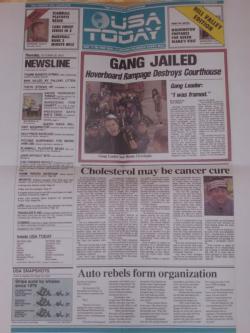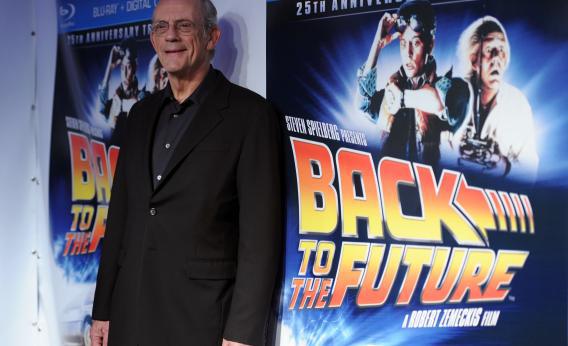New York political columnist Jonathan Chait had the clever idea to look at the journalistic shortcomings of the Hill Valley Telegraph, the fictional newspaper featured in the Back to the Future trilogy.
Like Chait, I recently rewatched the second part of the series, the one in which the Marty McFly and Doc Brown of 1985 visit the Marty McFly of 2015 to try to save his future children from prison. Of course, by messing with time, they doom the world to a dystopian nightmare.
Chait’s concept was fun, but there are some major flaws in his arguments. While he is correct that the editors of the Telegraph are atrocious headline writers—“Eisenhower Vetoes Senate Bill” being the typically uninformative banner Chait points to—he makes a number of mistakes regarding their news judgment and basic futurology.
First, he seems to think that it would be absurd for a small-town newspaper to feature large banner headlines on local issues like lightning striking the town clock tower, the murder of a local author, or a fire that destroys the 435-acre estate of an eccentric local scientist.
As my colleague and FT blogger Will Oremus pointed out via email, the prominence of these headlines would be perfectly normal for a town of Hill Valley’s size:
Having worked at a local newspaper for four years, I can vouch that a fire destroying a local mansion would in fact merit a banner headline on any but the biggest news day. A lightning strike that damages a local landmark, freezing the town clock tower at 10:04, would likewise be a top story, easy. Murders, especially of locally known figures, are also rare enough to be top stories in small cities.
Chait also faults the Telegraph for its reporting on Biff Tannen’s meteoric accumulation of an unprecedented gambling fortune. But he doesn’t know how big Biff’s bets were and thus can’t judge how important the story was. If Biff’s first big score was a $1,000 bet on a 100-to-1 horse for a $100,000 win in 1958 dollars, then that would be quite a good local news story indeed.
But Chait’s biggest problem is that he’s just not thinking fourth dimensionally.
For example, he is shocked that Emmett Brown being committed to an insane asylum merited a banner headline in 1983 on the same day that “Richard Nixon brazenly [violated] the 22nd Amendment to seek a fifth presidential term.”

Still from Back to the Future Part II © Universal Studios. All rights reserved.
What Chait doesn’t recognize is that the 1983 headline is part of an altered timeline in which Biff Tannen is probably a multi-multi-multi-billionaire and one of the most powerful men in world history. In the altered universe, Tannen’s company Biffco has apparently placed a great deal of its influence behind the corrupt Richard Nixon and probably, by extension, also supported a successful campaign to amend the Constitution to repeal presidential term limits. Furthermore, he likely has complete control of the local—and probably national—media. Biff could also easily have had political reasons for wanting to see that Doc Brown’s sectioning got banner placement ahead of what would have been a well-expected sixth presidential run for Nixon.
Finally, Chait falls prey to a reverse version of a psychological phenomenon reported in yesterday’s New York Times known as the “end of history illusion,” by which we struggle to imagine our future selves being much different from our present selves. Chait faults the Robert Zemeckis of 1989 for his failure to predict the rise of digital media and the death of print:
Perhaps the strangest assumption in both movies is not only that the Telegraph would exhibit such odd news judgment, but that it would also nevertheless continue to publish in print well into 2015.
First off, Zemeckis didn’t predict that the Telegraph would still be around in 2015. He fell prey to his own “end of history” mindset and—based on the trends of his day—forecast that the national behemoth USA Today would overtake the Telegraph as the local paper of choice.
Finally, Chait missed the one time where BTTF’s fictional newspaper editors showed genuinely atrocious news judgment. If you look at the sixth headline under “Newsline” in the above photo, you’ll see a bolded headline “PRESIDENT SAYS SHE’S TIRED” followed by the much smaller typeface “of reporters asking the same questions.” How is this news? Also, they got the dates of Hillary Clinton’s presidency totally wrong.
